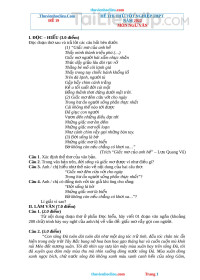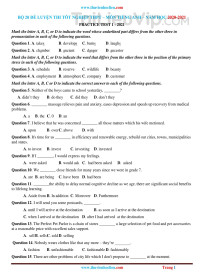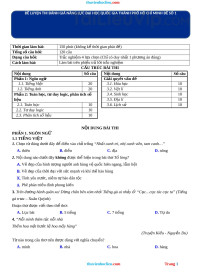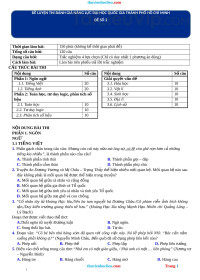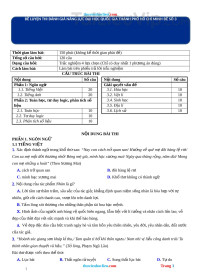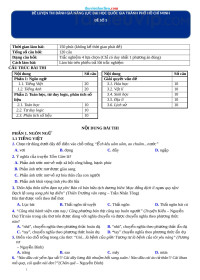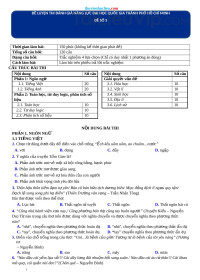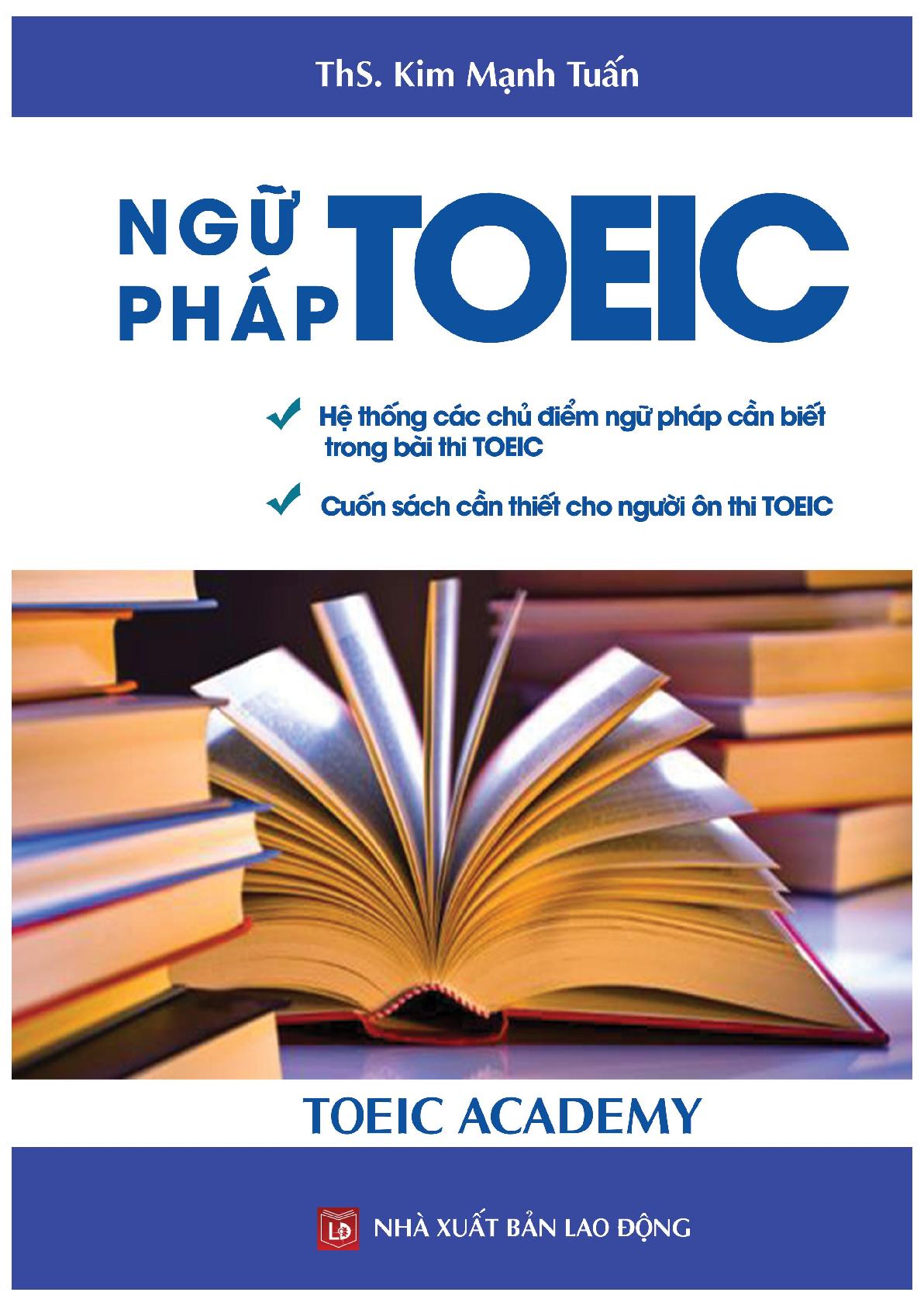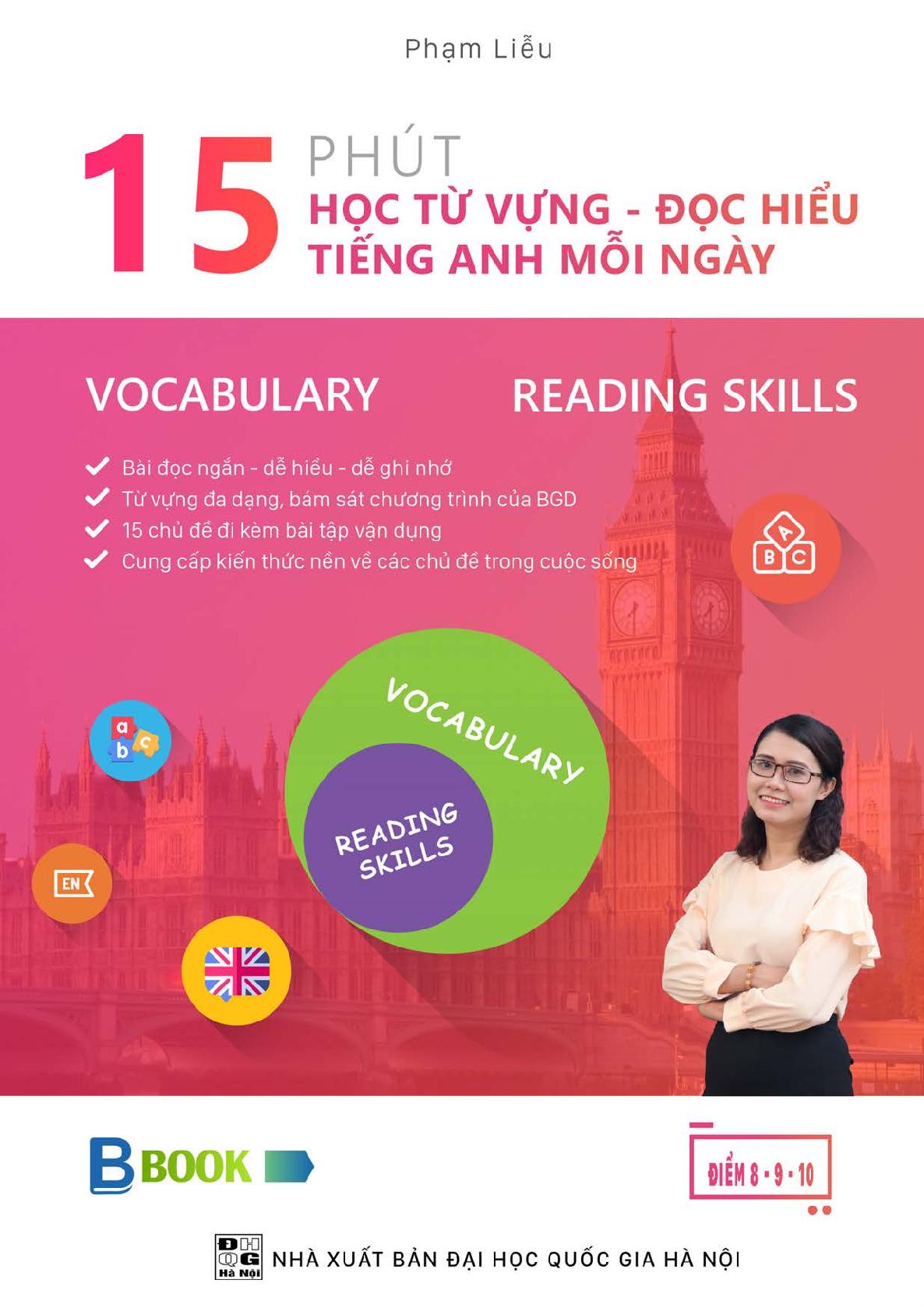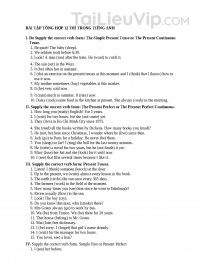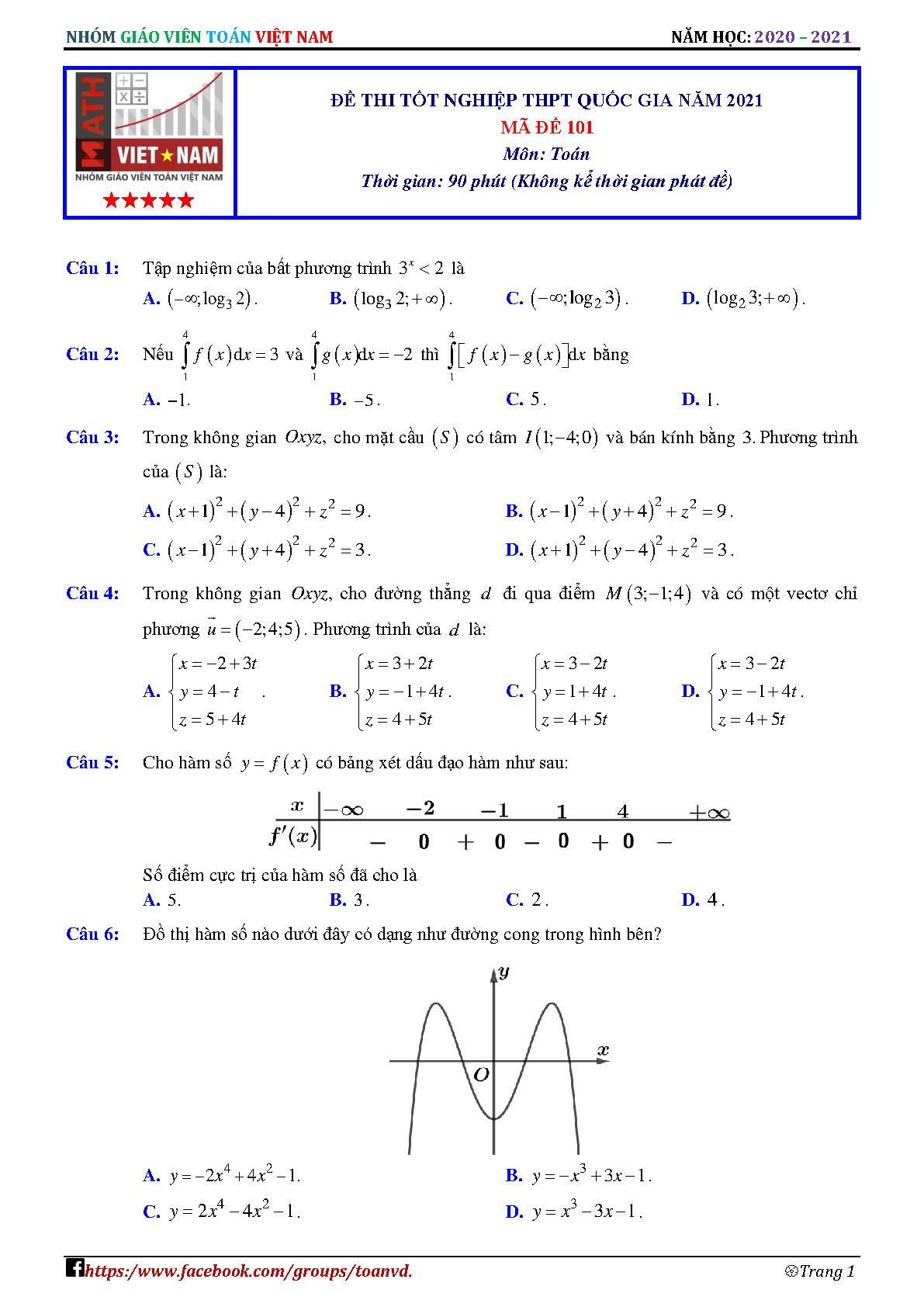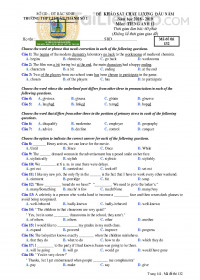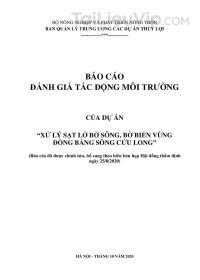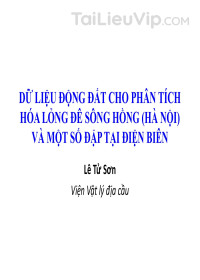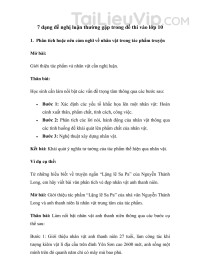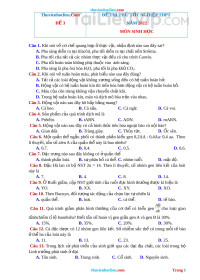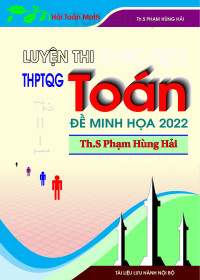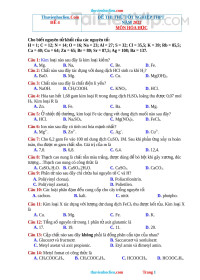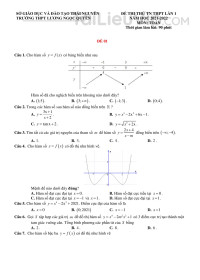thuvienhoclieu .com Thuvienhoclieu .ComĐ 1Ề Đ THI TH T T NGHI P THPT Ề Ử Ố ỆNĂM 2022MÔN TI NG ANHẾH , tên thí sinh:…………………………………………………………………………ọS báo danh:....................................................................................................................ố Mark the letter A, B, C, or D on your answer sheet to indicate the word whose underlined part differs from Question 1: A. complain ed B. roar ed C. exist ed D. decay edQuestion 2: A. cr ea ture B . cr ea my C. cr ea tive D. cr ea seMark the letter A, B, C, or D on your answer sheet to indicate the word that differs from the other three inthe position of primary stress in each of the following questions. Question 3: A. struggle B. answer C. confide D. comfort Question 4: A. inflation B. maximum C. applicant D. character Mark the letter A, B, C, or D on your answer sheet to indicate the correct answer to each of the followingquestions. Question 5: Tom invited us to come to his party, ?A . couldn't he B. wasn't he C. hadn't he D. didn't heQuestion 6: The injured ———————- to the hospital in an ambulance. A . were taking B. was taking C. were taken D. have taken Question 7: Sometimes she does not agree her husband about child rearing but they soon find the solutions. A. with B. for C. on D. ofQuestion 8: The greater the demand, the price. A. the highest B. the high C. higher D. the higherQuestion 9: Indiana University, one of the largest in the nation, is located in a town.A. small beautiful Midwestern B. beautiful Midwestern smallC. Midwestern beautiful small D. beautiful small MidwesternQuestion 10: I broke my teeth when I dinner.A. had B. was having C. am having D. am havingQuestion 11: _______ I’d like to help you out, I’m afraid I just haven’t got any spare money at the moment. A. Although B. However C. Despite D. In spite of Question 12: John will look for a job __________.A. after he had passed his exams B . as soon as he passes his examsC. while he was passing his D . before he passed his examsQuestion 13: ________ a scholarship, I entered one of the most privileged universities of the United Kingdom.A. To award B. Being awardedC. Having awarded D. Having been awardedQuestion 14: Euthanasia, also a mercy killing, is the practice of ending a life so as to release an individual froman incurable disease or _________ suffering.A. tolerated B. tolerant C. tolerate D. intolerableQuestion 15: There are other problems of city life which I don't propose to ____ at the moment.A. go into B. go around C. go for D. go up Question 16: The government should take some measures to that tourism develops inharmony with the environment.A. promote B. ensure C. facilitate D. improveQuestion 17: With a good _________ of both Vietnamese and English, Miss Loan was assigned the task of oralinterpretation for the visiting American delegation. thuvienhoclieu .com Trang 1thuvienhoclieu .comA. insight B. knowledge C. command D. proficiencyQuestion 18: Jimmy always takes the ________ by the horns at every chance in order to become a famous pop star, which is why he is so successful now.A. bull B. horse C. cow D. buffalo Question 19: Tourism is changing rapidly as nature, heritage, and recreational destinations become more important, and as conventional tourism is forced to _______ tougher environmental requirements.A. meet B. impose C. lay D. set Mark the letter A, B, C or D to indicate the word(s) CLOSEST in meaning to the underlined word(s) in each of the following questions.Question 20 : The protesters were angry with the council’s plan to do away with a lovely old building and put acar park there instead. A. destroy B. replace C. remain D. keep Question 2 1 : There are many TV commercials which distracting viewers from watching their favorite films. A. economics B. businesses C. contests D. advertisements Mark the letter A, B, C or D to indicate the word(s) OPPOSITE in meaning to the underlined word(s) in each of the following questions.Question 2 2 : Many people perished in the Kobe earthquake because they were not prepared for it. A. survived B. departed C. lost their lives D. declined Question 2 3 : The writer was really hot under the collar when his novel was mistaken for another. A. angry B. worried C. calm D. curious Mark the letter A, B, C, or D on your answer sheet to indicate the sentence that best completes each of the following exchangesQuestion 2 4 : Mai and Lan are friends.Lan asks Mai about Mai's plan. Select the most suitable response to fill in the blank.Lan: “Are you going to see the live show by Son Tung today?” Mai: “__________”.A. Yes, I enjoyed it very muchB. Maybe I'll be outC. Yes, I'm going to stay inD. I think soQuestion 2 5 : Mary invited her friend, Sarah, to have dinner out that night and Sarah accepted. Choose the most suitable response to fill in the blank in the following exchange.Mary: “Shall we eat out tonight?” - Sarah: “___________.”A. It's kind of you to inviteB. You are very welcomeC. That's a great ideaD. That's acceptable Read the following passage and mark the letter A, B, C, or D on your answer sheet to indicate the correctword or phrase that best fits each of the numbered blanks from 25 to 29.In such a costly and competitive society and world, no one of us can live without money. We need money tofulfill our basic needs of the life such as buying food, and (2 6 ) ________ many basic necessities of life whichare almost impossible to buy without money. People in the society (2 7 )______are rich and have property arelooked as honourable and respectful person of the society however a poor person is seen as hatred without anygood impression. Money increases the position of the person in the society and (2 8 )______a good impression to him. All ofus want to be rich by earning more money through good job or business in order to fulfil all the increasingdemands of the modern age. (2 9 )______, only few people get this chance of completing their dreams of being amillionaire. So, money is the thing of great importance all through the life. Money is required by everyone whetherhe/she is rich or poor and living in urban areas or rural areas. People in the urban areas are earning more moneythan the people living in backward or rural areas as the people of the urban areas have more (30)______to thetechnologies and get more opportunity because of the easy sources. (Adapted from https://www.indiacelebrating.com)Question 2 6 : A . other B . some C . many D . few thuvienhoclieu .com Trang 2thuvienhoclieu .comQuestion 2 7 : A . where B. what C . who D . which Question 2 8 : A . gives B . does C . takes D . draws Question 2 9 : A . Besides B . Therefore C . Moreover D . However Question 30 : A . way B . exit C . access D . order Read the following passage and mark the letter A, B, C, or D on your answer sheet to indicate the correctanswer to each of the questions from 31 to 35.In 2007, at a heavily hyped press event in San Francisco, Apple co-founder Steve Jobs stood on stage andunveiled a revolutionary product that not only broke the mould but also set an entirely new paradigm forcomputer-based phones. The look, interface and core functionality of nearly every smartphone to come alongsince is, in some form or another, derived from the original iPhone’s innovative touchscreen-centric design.Among some of the ground-breaking features was an expansive and responsive display from which tocheck email, stream video, play audio, and browse the internet with a mobile browser that loaded full websites,much like what is experienced on personal computers. Apple’s unique iOS operating system allowed for a widerange of intuitive gesture-based commands and eventually, a rapidly growing warehouse of downloadable third-party applications. Most importantly, the iPhone reoriented people’s relationship with smartphones. Up to then, they weregenerally geared toward businesspeople and enthusiasts who saw them as an invaluable tool for stayingorganized, corresponding over email, and boosting their productivity. Apple’s version took it to a whole otherlevel as a full-blown multimedia powerhouse, enabling users to play games, watch movies, chat, share content,and stay connected to all the possibilities that we are all still constantly rediscovering.(Adapted from https://www.thoughtco.com/ )Question 31: Which best serves as the title for the passage?A. Apple co-founder Steve Jobs B. press event in San FranciscoC. Apple’s unique iOS operating system D. Apple’s iPhoneQuestion 32: The word “ paradigm ” in paragraph 1 is closest in meaning to ______.A. media B. pattern C. role D. areaQuestion 3 3 : Which is NOT mentioned in paragraph 1 as a characteristic of the new iPhone?A. new look B. interface C. excellent sound D. core functionalityQuestion 3 4 : The word “ that ” in paragraph 1 refers to ______.A. mobile browser B. internet C. email D. audioQuestion 3 5 : The iPhone reoriented people’s relationship with smartphones and geared toward ______.A. businesspeople B. organizers C. producers D. gamersRead the following passage and mark the letter A, B, C, or D on your answer sheet to indicate the correctanswer to each of the questions from 36 to 42.Today, Snyder is seeing the fruits of the collaboration. In a recent issue of the Journal of ComparativePsychology (Vol. 117, No. 3), the research group published the first study of giant panda cub-rearing andseparation. The study is the first step in examining the impact of a common breeding practice in China:separating captive cubs before they are six months old so that the mothers will be able to reproduce againsooner. Cubs in the wild stay with their mothers for 1.5 to 2.5 years.Snyder and her co-authors, including Maple and psychologist Mollie Bloomsmith, PhD, theorize thatseparating cubs from their mothers too early may harm their social development, and could underlie why so thuvienhoclieu .com Trang 3thuvienhoclieu .commany captive pandas fail to breed. Captive males often show little sexual interest in females or are tooaggressive.The research team has also conducted urinary and behavioral analyses of female giant pandas during thebreeding season, which is generally in the spring, and is examining the behavior of giant panda mothers.Graduate student Megan Wilson, who also has worked in Chengdu, is investigating sequences of play-fightingfor her dissertation. And former graduate student and Chengdu researcher Loraine Tarou, PhD, examined giantpanda cognition.Tarou, now an assistant professor at Grand Valley State University in Michigan, is the first to examinehow captive pandas forage for food and learn to adapt to changes in their environment. She compared herfindings with the cognition of the spectacled bear and found that while both use spatial memory to find food, thespectacled bears used visual cues the pandas did not pick up on.The finding indicates that giant pandas' reliance on spatial memory alone may cause them to havedifficulty when their food sources are abruptly changed or moved--a big problem for an animal that consumesnearly 30 pounds of bamboo a day.While such basic research may not have immediate application, says Tarou, it is contributing to scientists'growing knowledge of the species.(Adapted from https://www.apa.org/ )Question 3 6 : Which of the following best serves as the title for the article?A. Learning about pandas B. Understanding breeding practice of pandasC. Snyder and her co-authors’ theory D. How captive pandas forage for foodQuestion 3 7 : Naturally, panda cubs stay with their mothers for ______.A. 1 to 1.5 years B. 1.5 to 2.5 years C. 2.5 to 3 years D. 3 to 4 yearsQuestion 3 8 : The word “ underlie ” in paragraph 2 most probably means ______.A. obtain B. generate C. explain D. developQuestion 3 9 : What analyses has been done on female giant pandas during the breeding season?A. spatial memory analyses B. environment interaction analysesC. food analyses D. urinary and behavioral analysesQuestion 40 : The word “ conducted ” in paragraph 3 is closest in meaning to ______.A. look for B. carry out C. get on D. set offQuestion 4 1 : Which of the following is infered according to the article?A. Captive panda cubs in China are often separated from mothers before they are six months.B. Separating cubs from their mothers early may be beneficial to their social development.C. Megan Wilson and Loraine Tarou examined panda breeding season.D. A panda consumes nearly 300 pounds of bamboo a day.Question 4 2 : The word “ them ” in paragraph 5 refers to ______.A. difficulties B. memories C. food sources D. giant pandasMark the letter A, B, C, or D on your answer sheet to indicate the underlined part that needs correction in each of the following questions.Question 43: Many students took part in the entrance examination at university highly every year A B C DQuestion 44: Many successful film directors are former actors who desire to expand his A B C D thuvienhoclieu .com Trang 4thuvienhoclieu .comexperience in the film industry.Question 45 : I don’t think it would be political to ask for loan just nowA B C DMark the letter A, B, C, or D on your answer sheet to indicate the sentence that is closest in meaning to eachof the following questions Question 46: It has been a long time since they met. A. They haven’t met since a long time. B. They haven’t met for a long time. C. They didn’t meet for a long time. D. They didn’t meet a long time ago.Question 47: “I will pay back the money, Gloria.” Said Ivan.A . Ivan apologized to Gloria for borrowing her money.B . Ivan offered to pay Gloria the money back.C . Ivan promised to pay back Gloria’s money.D . Ivan suggested paying back the money to Gloria.Question 48: My children are possibly in the living room.A. My children will be playing in the living room.B . My children cannot be in the kitchen.C . I do not know whether my children are in the living room.D . My children might be in the living room.Mark the letter A, B, C, or D on your answer sheet to indicate the sentence that best combines each pair of sentences in the following questionsQuestion 49: I regret not booking the seats in advance.A. I wish I book the seats in advance.C. If only I booked the seats in advance.B. I wish I have booked the seats in advance.D. If only I had booked the seats in advanceQuestion 50: We arrived at the cinema. Then we realized our tickets were still at home.A . No sooner had we realized that our tickets were still at home than we arrived at the cinema.B . Not until we arrived at the cinema that we realized that our tickets were still at homeC . Only after we arrived at the cinema did we realize that our tickets were at home.D . Hardly had we arrived at the cinema than we realized that our tickets were still at home.GI I CHI TI TẢ ẾQuestion 1. C.A.complain ed /k m ple nd/ə ˈ ɪB.roar ed /r (r)d/ɔːC.exist ed / z st d/ɪɡˈ ɪ ɪD.decay ed /d ke d/ɪˈ ɪĐuôi “ed” đáp án C đ c phát âm là / d/ còn trong đáp án A, B, D đ c phát âm là /d/. Đáp án C.ở ượ ɪ ượQuestion 2. C.A.cr ea ture / kri t (r)/ˈ ː ʃəB.cr ea my / kri mi/ˈ ːC.cr ea tive /kri e t v/ˈ ɪ ɪD.cr ea se /kri s/ːPh n gach chân đáp án C đ c phát âm là /i/ còn trong đáp án A, B, D đ c phát âm là /i:/. Đáp án C.ầ ở ươ ượ thuvienhoclieu .com Trang 5thuvienhoclieu .comQuestion 3. C.A.struggle / str l/ˈ ʌɡB.answer / ns (r)/ˈɑː əC.confide /k n fa d/ə ˈ ɪD.comfort / k mf t/ˈ ʌ əCác đáp án A, B, D có tr ng âm r i vào âm ti t th nh t. Đáp án C có tr ng âm r i vào âm ti t th 2.ọ ơ ế ứ ấ ọ ơ ế ứ Đáp án CQuestion 4. A.A.inflation / n fle n/ɪ ˈ ɪʃB.maximum / mæks m m/ˈ ɪ əC.applicant / æpl k nt/ˈ ɪ əD.character / kær kt (r)/ˈ ə əCác đáp án B, C, D có tr ng âm r i vào âm ti t th nh t. Đáp án A có tr ng âm r i vào âm ti t th 2.ọ ơ ế ứ ấ ọ ơ ế ứĐáp án AQuestion 5. DCâu h i đuôiỏM nh đ th kh ng đ nh, tr đ ng t th ph đ nh + S?ệ ề ể ẳ ị ợ ộ ừ ể ủ ịM nh đ ph đ nh thì quá kh đ n nên s a nh sau:ệ ề ủ ị ở ứ ơ ử ưInvited => Didn’t he=>Ch n DọQuestion 6. CPh ng pháp gi i: ươ ảKi n th c:ế ứ Câu b đ ng: ị ộGi i chi ti t: ả ế Câu b đ ng thì Quá kh đ n . ị ộ ứ ơ Hành đ ng đ c nh n m nh là ng i b th ng đ c mang ộ ượ ấ ạ ườ ị ươ ượt i b nh vi n .ớ ệ ệS + đ ng t to be quá kh + V-ed/V3ộ ừ ở ứT m d chạ ị : Ng i b th ng đ c mang t i b nh vi n b ng xe c u th ng.ườ ị ươ ượ ớ ệ ệ ằ ứ ươQuestion 7. AC m t : Agree with (đ ng ý v i ai)ụ ừ ồ ớAgree about/on (đ ng ý v cái gì) =>Lo i Cồ ề ạ=>Ch n AọT m d ch: Đôi khi cô y không đ ng ý v i ch ng c a mình v vi c nuôi con nh ng h s m tìm ra các gi iạ ị ấ ồ ớ ồ ủ ề ệ ư ọ ớ ảpháp.Question 8. DC u trúc so sánh képấThe + comparative + S + V + the + comparative + S + V=> Đáp án DT m d ch: Nhu c u càng l n, giá càng cao.ạ ị ầ ớQuestion 9. DTr t t c a các tính tậ ự ủ ừ1 2 3 4 5 6 7 8General opinion Specific opinionSize Age Shape Colour Nationality/origin MaterialTính t ch quanừ ỉđi m, ý ki n m tể ế ộcách chung chung Tính t ch quanừ ỉđi m, ý ki nể ếm t cách c thộ ụ ể Tính từch kíchỉcỡ Tính từch tu iỉ ổtác Tính từch hìnhỉd ngạ Tính từmàu s cắ Tính t ch qu c t ch,ừ ỉ ố ịngu n g cồ ố Tính từ thuvienhoclieu .com Trang 6thuvienhoclieu .com“ beautiful” => “ small” => 3 “ Midwestern => 7Đáp án DT m d ch: ạ ị Đ i h c Indiana, m t trong nh ng tr ng l n nh t trong c n c, t a l c t i m t th tr n nh ạ ọ ộ ữ ườ ớ ấ ả ướ ọ ạ ạ ộ ị ấ ỏ ởTrung Tây xinh đ p.ẹQuestion 10. BC u trúc: khi đang làm gì (quá kh đ n) thì có ho t đ ng khác xen vào (quá kh ti p di n).S + was/were + V-ấ ứ ơ ạ ộ ứ ế ễing + when/while + S + V-ed/V2.T m d ch: Tôi đang ăn c m thì b gãy răng.ạ ị ơ ịQuestion 11. AKi n th c: ế ứ M nh đ nh ng bệ ề ượ ộGi i chi ti t: ả ếA. Although + m nh đ : M c dùệ ề ặB. However + m nh đ : Tuy nhiênệ ềC. Despite + c m danh t / V_ing: M c dùụ ừ ặD. In spite of + c m danh t / V_ing: M c dùụ ừ ặSau ch tr ng là “I’d like to help you out” là m t m nh đ => lo i C, Dỗ ố ộ ệ ề ạT m d ch:ạ ị M c dù tôi mu n giúp đ b n, tôi s r ng tôi không có ti n đ dành vào lúc này.ặ ố ỡ ạ ợ ằ ề ểQuestion 12. BKi n th c v m nh đ tr ng ng ch th i gianế ứ ề ệ ề ạ ữ ỉ ờ* Ta có m nh đ : ệ ềJohn will look for a job: chia thì t ng lai đ n nên m nh đ ch th i gian ph i thì hi n t i đ nươ ơ ệ ề ỉ ờ ả ở ệ ạ ơQuestions 13.Đáp án DKi n th c v rút g n câuế ứ ề ọT m d chạ ị : Đ c nh n h c b ng, tôi vào h c t i m t trong nh ng tr ng đ i h c đ c quy n nh t c a ượ ậ ọ ổ ọ ạ ộ ữ ườ ạ ọ ặ ề ấ ủV ng qu c Anh.ươ ố+ Hai v có cùng ch ng là “I”, ta có th b ch ng v đ u, đ ng th i chuy n đ ng t v d ng Ving khi ế ủ ữ ể ỏ ủ ữ ế ầ ồ ờ ể ộ ừ ề ạnó mang nghĩa ch đ ng và Vp2/Ved khi nó mang nghĩa b đ ng.ủ ộ ị ộ+ Vì hành đ ng “đ c nh n h c b ng” x y ra tr c hành đ ng còn l i trong câu nên ta dùng “having been ộ ượ ậ ọ ổ ả ướ ộ ạVp2/Ved”.Question 14.Đáp án DKi n th c v t lo iế ứ ề ừ ạA. tolerated: Vp2 c a “tolerate”ủB. tolerant / t l r nt/ (a): có th ch u đ ng, có th ch p nh nˈ ɑː ə ə ể ị ự ể ấ ậC. tolerate / t l re t/ (v): ch u đ ngˈ ɑː ə ɪ ị ựD. intolerable / n t l r bl/ (a): không th ch u đ ng đ cɪ ˈ ɑː ə ə ể ị ự ượT m d ch:ạ ị Euthanasia, cũng là “mercy killing” (s gi t ng i không th ng ti c), là vi c ti n hành k t thúcự ế ườ ươ ế ệ ế ếm t cu c s ng đ gi i thoát m t cá nhân kh i m t căn b nh nan y ho c đau kh không th ch u đ ng đ c.ộ ộ ố ể ả ộ ỏ ộ ệ ặ ổ ể ị ự ượQuestion 15. AKi n th c v c m đ ng tế ứ ề ụ ộ ừA. go into (phr.v): b t đ u làm gì; th o lu n, ki m ch ng, mô t , gi i thích m t cách chi ti t và th n tr ngắ ầ ả ậ ể ứ ả ả ộ ế ậ ọB. go around (phr.v): đ cho m i ng i trong nhóm; đ n thăm ai; c x tủ ọ ườ ế ư ử ệC. go for (phr.v): ch n, say mê, c g ngọ ố ắD. go up (phr.v): tăng lênT m d chạ ị : Còn nhi u v n đ khác v cu c s ng thành th cái mà tôi không mu n đi vào sâu đ th o lu n ề ấ ề ề ộ ố ị ố ể ả ậk ngay lúc này. ỹQuestion 16. Bpromote (v); đ y m nh, thúcẩ ạ đ yẩensure (v): b oả đ mảfacilitate (v): t o đi u ki n thu nạ ề ệ ậ l iợ thuvienhoclieu .com Trang 7thuvienhoclieu .comimprove (v): c iả thi nệC u trúc: ensure + that + a clause (b o đ m r ng ...)ấ ả ả ằD ch: Chính ph nên có m t s bi n pháp đ đ m b o du l ch phát tri n hài hòa v i môi tr ng.ị ủ ộ ố ệ ể ả ả ị ể ớ ườQuestion 17 . CKi n th c v t v ngế ứ ề ừ ựA. insight / nsa t/ (n): s th u hi u, hi u đ c cái gìˈɪ ɪ ự ấ ể ể ượB. knowledge / n l d / (n): ki n th c chung chungˈ ɑː ɪ ʒ ế ứC. command /k mænd/ (n): ki n th c v cái gì, kh năng làm gì (đ c bi t là ngo i ng )əˈ ế ứ ề ả ặ ệ ạ ữD. proficiency /pr f nsi/ (n): s thành th oəˈ ɪʃ ự ạ=> C m t : ụ ừ a command of sth: ki n th c v m t môn h c c th , đ c bi t là kh năng nói ngo i ngế ứ ề ộ ọ ụ ể ặ ệ ả ạ ữT m d ch:ạ ị Thông th o c ti ng Vi t và ti ng Anh, cô Loan đ c giao nhi m v thuy t trình cho phái đoàn ạ ả ế ệ ế ượ ệ ụ ếM đ n thăm.ỹ ếQuestion 18. AKi n th c v thành ng ế ứ ề ữTa có:Take the bull by the horns: đ ng đ u v i khó khănươ ầ ớT m d chạ ị : Jimmy luôn luôn đ ng đ u v i khó khăn đ tr thành m t ngôi sao nh c pop n i ti ng, đó là ươ ầ ớ ể ở ộ ạ ổ ếđi u mà t i sao anh y thành công ngay bây gi . ề ạ ấ ờ=> Đáp án là A C u trúc khác c n l u ý:ấ ầ ưIn order to do sth: đ làm gì ểQuestion 19. AKi n th c v t v ng/ c m t ế ứ ề ừ ự ụ ừTa có: - Meet the requirements: đáp ng nh ng yêu c uứ ữ ầ- Impose a burden/hardship on sb: áp đ t gánh n ng lên ai ặ ặ- Lay the foundations/groundwork/base for sth: đ t n n móng cho cái gìặ ề- Set standards/limits/guidelines: đ a ra tiêu chu n, gi i h n, h ng d n ư ẩ ớ ạ ướ ẫT m d chạ ị : Du l ch đang thay đ i m t cách nhanh chóng b i vì thiên nhiên, di s n, và các đ a đi m vui ch i ị ổ ộ ở ả ị ể ơgi i trí đang ngày càng quan tr ng h n, và b i vì du l ch thông th ng b b t bu c ph i đáp ng đ c nh ngả ọ ơ ở ị ườ ị ắ ộ ả ứ ượ ữyêu c u v môi tr ng ngày càng kh t khe h n. ầ ề ườ ắ ơ=> Đáp án là A Question 20. A Ki n th c: T đ ng nghĩa ế ứ ừ ồGi i thích: ảdo away with: xóa b , th tiêu ỏ ủA. destroy (v): phá b , phá h y ỏ ủ B. replace (v): thay th ếC. remain (v): còn l i, v n v y ạ ẫ ậ D. keep (v): gi l i ữ ạ=> do away with = destroy T m d ch: Nh ng ng i bi u tình t c gi n v i k ho ch c a H i đ ng thành ph là phá b m t tòa nhà cũ ạ ị ữ ườ ể ứ ậ ớ ế ạ ủ ộ ồ ố ỏ ộxinh x n và đ t m t bãi đ u xe đó. ắ ặ ộ ậ ởQuestion 2 1 . D Ki n th c: T đ ng nghĩa ế ứ ừ ồGi i thích: ảcommercials (n): qu ng cáo ảA. economics (n): kinh t h c ế ọ B. businesses (n): doanh nghi p ệC. contests (n): các cu c thi ộ D. advertisements (n): qu ng cáo ả=> commercials = advertisements T m d ch: Có nhi u qu ng cáo truy n hình khi n ng i xem m t t p trung khi xem nh ng b phim yêu ạ ị ề ả ề ế ườ ấ ậ ữ ộthích c a h .ủ ọ thuvienhoclieu .com Trang 8thuvienhoclieu .comCh n D ọQuestion 2 2 . A Ki n th c: T trái nghĩa ế ứ ừGi i thích: ảperish (v): b m ng, ch t ỏ ạ ếA. survive (v): s ng sót ố B. depart (v): t tr n, ch t ừ ầ ếC. lost their lives: đánh m t s s ng c a h ấ ự ố ủ ọ D. decline (v): t ch i, kh c t ừ ố ướ ừ=> perish >< survive T m d ch: Nhi u ng i thi t m ng trong tr n đ ng đ t Kobe vì h không chu n b cho s x y ra c a nó. ạ ị ề ườ ệ ạ ậ ộ ấ ọ ẩ ị ự ả ủCh n A ọQuestion 2 3 . C Ki n th c: T trái nghĩa ế ứ ừGi i thích: ảhot under the collar: t c gi n v đi u gì đó ứ ậ ề ềA. angry (a): n i gi n ổ ậ B. worried (a): lo l ng ắC. calm (a): bình tĩnh D. curious (a): tò mò, hi u kì ế=> hot under the collar >< calm T m d ch: Tác gi th c s r t t c gi n khi ti u thuy t c a anh y b nh m l n v i ng i khác. ạ ị ả ự ự ấ ứ ậ ể ế ủ ấ ị ẫ ẫ ớ ườCh n C ọQuestion 2 4. DGi i thích:ảA. Yes, I enjoyed it very much: Có ch , tôi đã thích nó l m.ứ ắB. Maybe I’ll be out: Có th là tôi s ra ngoài.ể ẽC. Yes, I’m going to stay in: Có ch , tôi đ nh nhà.ứ ị ởD. I think so: Tôi nghĩ v y.ậA sai vì h i t i nay đi không mà l i nói là “đã thích”, nh v y hi u là đã đi tham d , và th y thích nó.ỏ ố ạ ư ậ ể ự ấB sai vì tr l i không đúng tr ng tâm, h i có tham gia không mà nói tôi s ra ngoài?ả ờ ọ ỏ ẽC sai vì phía tr c thì nói có (đi), phía sau l i b o nhà, mâu thu n.ướ ạ ả ở ẫD ch nghĩa: Mai và Lan là b n. Lan h i Mai v k ho ch c a Mai.ị ạ ỏ ề ế ạ ủ- C u đ nh đi xem live-show c a S n Tùng hôm nay à?ậ ị ủ ơ- T nghĩ v y.ớ ậQuestion 2 5. CGi i thích:ảA. It’s kind of you to invite: B n th t t t khi đã m i (Th c t câu này thi u tân ng me sau invite, nh ng ạ ậ ố ờ ự ế ế ữ ở ưdù có thêm vào thì đây cũng không ph i là cách ph bi n đ tr l i cho l i m i này)ả ổ ế ể ả ờ ờ ờB. You are very welcome (dùng khi ng i khác c m n)ườ ả ơC. That’s a great idea: Ý hay đó (Dùng đ đ ng ý l i đ ngh l i m i)ể ồ ờ ề ị ờ ờD. That’s acceptable: Có th ch p nh n đ c (v nghĩa thì đúng nh ng không ai dùng cách này đ đáp l i l iể ấ ậ ượ ề ư ể ạ ờm i)ờD ch nghĩa:ị- Chúng ta ra ngoài ăn t i nay nhé?ố- Ý hay đó. - Biên so n đ c quy n nghiêm c m sao chép, buôn bán trái phépạ ộ ề ấQuestion 2 6 . A Ki n th c: l ng t ế ứ ượ ừA. other : khác B. some : m t vàiộC. many : nhi uề thuvienhoclieu .com Trang 9.Tailieudoc vnthuvienhoclieu .comD. few : m t chút, m t ítộ ộWe need money to fulfill our basic needs of the life such as buying food, and other many basic necessities oflife which are almost impossible to buy without money.Chúng ta c n ti n đ đáp ng các nhu c u c b n c a cu c s ng nh mua th c ph m và nhi u nhu c u cầ ề ể ứ ầ ơ ả ủ ộ ố ư ự ẩ ề ầ ơb n khác c a cu c s ng g n nh không th mua n u không có ti n.ả ủ ộ ố ầ ư ể ế ềCh n A ọQuestion 27. C Ki n th c: Đ i t quan h ế ứ ạ ừ ệGi i thích: ảTrong m nh đ quan h : ệ ề ệ- where: thay th cho danh t ch n i ch n; where + S + V ế ừ ỉ ơ ố- who: thay th cho danh t ch ng i; đóng vai trò ch ng / tân ng ế ừ ỉ ườ ủ ữ ữ- which: thay th cho danh t ch v t; đóng vai trò ch ng / tân ng ế ừ ỉ ậ ủ ữ ữ- what (t nghi v n): cái gì ừ ấpeople (n): con ng i => who ườPeople in the society (26) who are rich and have property are looked as honourable and respectful person of the society however a poor person is seen as hatred without any good impression. T m d ch: Con ng i trong xã h i, nh ng ng i giàu có và nhi u tài s n đ c xem nh nh ng ng i đáng ạ ị ườ ộ ữ ườ ề ả ượ ư ữ ườkính tr ng và đ c tôn tr ng trong xã h i, tuy nhiên m t ng i nghèo l i b ghét b mà không có b t c n ọ ượ ọ ộ ộ ườ ạ ị ỏ ấ ứ ất ng t t đ p nào. ượ ố ẹCh n C ọQuestion 2 8 . A Ki n th c: S k t h p t ế ứ ự ế ợ ừGi i thích: ảA. gives (v): cho, đem l iạ B. does (v): làm, hành đ ng ộC. takes (v): c m, l y ầ ấ D. draws (v): v ẽgive a good impression to sb: cho ai n t ng t t ấ ượ ốMoney increases the position of the person in the society and (27) give a good impression to him. T m d ch: Ti n b c làm tăng v th c a con ng i trong xã h i và đem l i n t ng t t cho h . ạ ị ề ạ ị ế ủ ườ ộ ạ ấ ượ ố ọCh n A ọQuestion 2 9 . D Ki n th c: Liên t ế ứ ừGi i thích: ảA. Besides: ngoài ra B. Therefore + V: vì th ếC. Moreover, S + V: ngoài ra D. However, S + V: tuy nhiên (28) However, only few people get this chance of completing their dreams of being a millionaire. T m d ch: Tuy nhiên, ch m t vài ng i có đ c c h i đ đ t đ c gi c m tr thành tri u phú. ạ ị ỉ ộ ườ ượ ơ ộ ể ạ ượ ấ ơ ở ệCh n D ọQuestion 30 . C Ki n th c: T v ng ế ứ ừ ựGi i thích: ảA. way (n): đ ng, l i đi ườ ố B. exit (n): l i ra, c a ra ố ửC. access (n): s ti p c n ự ế ậ D. order (n): th , b c, giai c p ứ ậ ấPeople in the urban areas are earning more money than the people living in backward or rural areas as the people of the urban areas have more (29) access to the technologies and get more opportunity because of the easy sources. T m d ch: Nh ng ng i thành th ki m đ c nhi u ti n h n so v i nh ng ng i s ng khu v c h o ạ ị ữ ườ ở ị ế ượ ề ề ơ ớ ữ ườ ố ở ự ẻlánh hay nông thôn, nh ng ng i thành th đ c ti p c n v i công ngh và có đ c nhi u c h i h n b i ữ ườ ở ị ượ ế ậ ớ ệ ượ ề ơ ộ ơ ởvì đi m xu t phát c a h r t d dàng. ể ấ ủ ọ ấ ễCh n C ọ thuvienhoclieu .com Trang 10thuvienhoclieu .comRead the following passage and mark the letter A, B, C, or D on your answer sheet to indicate the correctanswer to each of the questions from 31 to 35.Question 31. D D ch nghĩa câu h i:ị ỏ L a ch n nào làm tiêu đ t t nh t cho đo n văn?ự ọ ề ố ấ ạA. Đ ng sáng l p Apple Steve Jobs ồ ậ B. s ki n báo chí San Franciscoự ệ ởC. H đi u hành iOS đ c đáo c a Apple ệ ề ộ ủ D. iPhone c a AppleủGi i thích:ả Đo n văn ch y u nói v đi n tho i iPhone m i ra m t c a Appleạ ủ ế ề ệ ạ ớ ắ ủvào năm 2007 nên ph ng án D phù h p nh t.ươ ợ ấQuestion 3 2 . B D ch nghĩa câu h i:ị ỏ T “ừ paradigm ” trong đo n 1 có nghĩa g n nh t v i ______.ạ ầ ấ ớA. ph ng ti n ươ ệ B. mô hình C. vai trò D. khu v cựGi i thích:ả “ paradigm ” có nghĩa là “mô hình”, g n nghĩa nh t v i ph ng án B.ầ ấ ớ ươQuestion 3 3 . C D ch nghĩa câu h i:ị ỏ Đi u nào KHÔNG đ c đ c p trong đo n 1 nh m t đ cề ượ ề ậ ạ ư ộ ặđi m c a iPhone m i?ể ủ ớA. v ngoài m i ẻ ớ B. giao di n ệ C. âm thanh tuy t v i ệ ờ D. ch cứnăng c t lõiốGi i thích:ả Thông tin có câu: “The look, interface and core functionality ofởnearly every smartphone to come along since is, in some form or another, derivedfrom the original iPhone’s innovative touchscreen-centric design.” T t c đ u đ cấ ả ề ượnh c đ n tr ph ng án C.ắ ế ừ ươQuestion 3 4 . D D ch nghĩa câu h i:ị ỏ T “ừ that ” trong đo n 1 đ c p đ n ______.ạ ề ậ ếA. trình duy t di đ ng ệ ộ B. internet C. email D. âm thanhGi i thích:ả “…and browse the internet with a mobile browserthat loaded fullwebsites, much like…”Question 3 5 . D D ch nghĩa câu h i:ị ỏ iPhone đ nh h ng l i m i quan h c a m i ng i v i đi nị ướ ạ ố ệ ủ ọ ườ ớ ệtho i thông minh và h ng t i ______.ạ ướ ớA. doanh nhân B. nhà t ch c ổ ứC. nhà s n xu t ả ấ D. ng i ch i trò ch iườ ơ ơGi i thích:ả Thông tin có câu: “Most importantly, the iPhone reoriented people’sởrelationship with smartphones. Up to then, they were generally geared towardbusinesspeople and…”D ch nghĩa toàn bài:ịVào năm 2007, t i m t s ki n báo chí đ c qu ng cáo r m r San Francisco, Steve Jobs, ng iạ ộ ự ệ ượ ả ầ ộ ở ườđ ng sáng l p Apple đã đ ng trên sân kh u và ti t l m t s n ph m mang tính cách m ng không ch phá vồ ậ ứ ấ ế ộ ộ ả ẩ ạ ỉ ỡkhuôn m u mà còn t o ra m t mô hình hoàn toàn m i cho đi n tho i d a trên máy tính. V ngoài, giao di nẫ ạ ộ ớ ệ ạ ự ẻ ệvà ch c năng c t lõi c a g n nh m i đi n tho i thông minh đi kèm lúc đó, d ng này hay d ng khác, đ cứ ố ủ ầ ư ọ ệ ạ ở ạ ạ ượxu t phát t thi t k trung tâm màn hình c m ng sáng t o c a iPhone.ấ ừ ế ế ả ứ ạ ủM t s tính năng đ t phá là màn hình m r ng và ph n h i nhanh đ ki m tra email, truy n phát video,ộ ố ộ ở ộ ả ồ ể ể ềphát âm thanh và duy t internet b ng trình duy t di đ ng t i các trang web đ y đ , gi ng nh nh ng gì cóệ ằ ệ ộ ả ầ ủ ố ư ữth tr i nghi m trên máy tính cá nhân. H đi u hành iOS đ c đáo c a Apple cho phép th c hi n m t lo t cácể ả ệ ệ ề ộ ủ ự ệ ộ ạl nh d a trên c ch tr c quan và cu i cùng, kho ng d ng c a bên th ba có th t i xu ng nhanh chóng.ệ ự ử ỉ ự ố ứ ụ ủ ứ ể ả ốQuan tr ng nh t, iPhone đã đ nh h ng l i m i quan h c a m i ng i v i đi n tho i thông minh.ọ ấ ị ướ ạ ố ệ ủ ọ ườ ớ ệ ạCho đ n lúc đó, h th ng h ng đ n các doanh nhân và nh ng ng i đam mê, nh ng ng i coi h là m tế ọ ườ ướ ế ữ ườ ữ ườ ọ ộcông c vô giá đ duy trì t ch c, liên l c qua email và tăng năng su t c a h . Phiên b n Apple đã đ a nó lênụ ể ổ ứ ạ ấ ủ ọ ả ư thuvienhoclieu .com Trang 11thuvienhoclieu .comm t c p đ hoàn toàn khác nh m t s c m nh đa ph ng ti n toàn di n, cho phép ng i dùng ch i trò ch i,ộ ấ ộ ư ộ ứ ạ ươ ệ ệ ườ ơ ơxem phim, trò chuy n, chia s n i dung và k t n i v i t t c các kh năng mà t t c chúng ta v n khôngệ ẻ ộ ế ố ớ ấ ả ả ấ ả ẫng ng khám phá.ừRead the following passage and mark the letter A, B, C, or D on your answer sheet to indicate the correctanswer to each of the questions from 36 to 42.Question 3 6 . A D ch nghĩa câu h i:ị ỏ L a ch n nào sau đây làm tiêu đ t t nh t cho bài vi t?ự ọ ề ố ấ ếA. Tìm hi u v g u trúc ể ề ấB. Tìm hi u th c hành nhân gi ng g u trúcể ự ố ấC. Snyder và đ ng tác gi lý thuy t c a cô yồ ả ế ủ ấD. G u trúc nuôi nh t ki m ăn nh th nào?ấ ố ế ư ếGi i thích:ả Bài đ c ch y u nói v g u trúc khi b nuôi nh t c th là vi cọ ủ ế ề ấ ị ố ụ ể ệtách chúng kh i m quá s m và nh ng nh h ng c a nó nên ph ng án Aỏ ẹ ớ ữ ả ưở ủ ươphù h p nh t.ợ ấQuestion 3 7 . B D ch nghĩa câu h i:ị ỏ Ngoài t nhiên, g u trúc con v i m c a chúng trongự ấ ở ớ ẹ ủ___.A. 1 đ n 1,5 năm ế B. 1,5 đ n 2,5 năm ế C. 2,5 đ n 3 năm ế D. 3 đ n 4ếnămGi i thích:ả Thông tin có câu: “Cubs in the wild stay with their mothers for 1.5ởto 2.5 years.”Question 3 8 . C D ch nghĩa câu h i:ị ỏ T “ừ underlie ” trong đo n 2 nhi u kh năng có nghĩa làạ ề ả______.A. thu đ c ượ B. t o ra ạ C. gi i thích ả D. phát tri nểGi i thích:ả “underlie” có nghĩa là “là c s c a”, g n nghĩa v i ph ng án C.ơ ở ủ ầ ớ ươQuestion 39. D D ch nghĩa câu h i:ị ỏ Nh ng phân tích nào đã đ c th c hi n trên g u trúc cáiữ ượ ự ệ ấkh ng l trong mùa sinh s n?ổ ồ ảA. phân tích b nh không gian ộ ớ B. phân tích t ng tác môi tr ngươ ườC. phân tích th c ăn ứ D. phân tích ti t ni u và hành viế ệGi i thích:ả Thông tin có câu: “The research team has also conducted urinaryởand behavioral analyses of female giant pandas during the breeding season,…”Question 40. B D ch nghĩa câu h i:ị ỏ T “ừ conducted ” trong đo n 4 có nghĩa g n nh t v iạ ầ ấ ớ______.A. tìm ki m ế B. th c hi n ự ệ C. trèo lên D. kh i hànhởGi i thích:ả “conducted” có nghĩa là “ti n hành”, g n nghĩa v i ph ng án B.ế ầ ớ ươQuestion 4 1 . A D ch nghĩa câu h i:ị ỏ Đi u nào sau đây là ề đ c suy raượ theo bài báo?A. Nh ng chú g u trúc con nuôi nh t Trung Qu c th ng b tách kh i mữ ấ ố ở ố ườ ị ỏ ẹtr c khi chúng đ c sáu tháng tu i.ướ ượ ổB. Tách thú con kh i m s m có th có l i cho s phát tri n xã h i c a chúng.ỏ ẹ ớ ể ợ ự ể ộ ủC. Megan Wilson và Loraine Tarou đã ki m tra mùa sinh s n c a g u trúc.ể ả ủ ấD. M t con g u trúc tiêu th g n 300 pound tre m i ngày.ộ ấ ụ ầ ỗGi i thích:ả Thông tin có câu: “The study is the first step in examining theởimpact of a common breeding practice in China: separating captive cubs beforethey are six months old so that…” thuvienhoclieu .com Trang 12thuvienhoclieu .comQuestion 4 2 . D D ch nghĩa câu h i:ị ỏ T “ừ them ” trong đo n 4 đ c p đ n ______.ạ ề ậ ếA. khó khăn B. ký c ứ C. ngu n th c ăn ồ ứ D. g u trúcấkh ng lổ ồGi i thích:ả “The finding indicates that giant pandas' reliance on spatialmemory alone may cause them to have difficulty when…”D ch nghĩa toàn bài:ịHôm nay, Snyder đang nhìn th y nh ng thành qu c a s h p tác. Trong m t s g n đây c a T p chíấ ữ ả ủ ự ợ ộ ố ầ ủ ạTâm lý h c so sánh (T p 117, S 3), nhóm nghiên c u đã công b nghiên c u đ u tiên v nuôi và tách g uọ ậ ố ứ ố ứ ầ ề ấtrúc kh ng l . Nghiên c u này là b c đ u tiên trong vi c ki m tra tác đ ng c a vi c th c hành chăn nuôiổ ồ ứ ướ ầ ệ ể ộ ủ ệ ựph bi n Trung Qu c: tách các con nuôi nh t tr c khi chúng đ c sáu tháng tu i đ các con thú m cóổ ế ở ố ố ướ ượ ổ ể ẹth sinh s n s m h n. Đàn con trong t nhiên v i m t 1,5 đ n 2,5 năm.ể ả ớ ơ ự ở ớ ẹ ừ ếSnyder và các đ ng tác gi c a cô, bao g m Maple và nhà tâm lý h c Mollie Bloomsmith, Ti n sĩ, đ aồ ả ủ ồ ọ ế ưra gi thuy t r ng tách đàn con ra kh i m quá s m có th gây h i cho s phát tri n xã h i c a chúng và cóả ế ằ ỏ ẹ ớ ể ạ ự ể ộ ủth hi u đ c t i sao r t nhi u g u trúc nuôi nh t không sinh s n. Con đ c b giam c m th ng th hi n ítể ể ượ ạ ấ ề ấ ố ả ự ị ầ ườ ể ệh ng thú tình d c v i con cái, ho c quá hung d .ứ ụ ớ ặ ữNhóm nghiên c u cũng đã ti n hành phân tích ti t ni u và hành vi c a g u trúc cái kh ng l trong mùaứ ế ế ệ ủ ấ ổ ồsinh s n, th ng là vào mùa xuân và đang ki m tra hành vi c a nh ng con g u trúc kh ng l . Sinh viên t tả ườ ể ủ ữ ấ ổ ồ ốnghi p Megan Wilson, ng i cũng đã làm vi c t i Thành Đô, đang đi u tra các chu i trò ch i chi n đ u choệ ườ ệ ạ ề ỗ ơ ế ấlu n án c a cô. Và c u sinh viên t t nghi p và nhà nghiên c u Thành Đô Loraine Tarou, Ti n sĩ, đã ki m traậ ủ ự ố ệ ứ ế ểnh n th c c a g u trúc kh ng l .ậ ứ ủ ấ ổ ồTarou, hi n là tr lý giáo s t i Đ i h c bang Grand Valley Michigan, là ng i đ u tiên ki m tra cáchệ ợ ư ạ ạ ọ ở ườ ầ ểg u trúc b nuôi nh t s c s o tìm th c ăn và h c cách thích nghi v i nh ng thay đ i trong môi tr ng c aấ ị ố ụ ạ ứ ọ ớ ữ ổ ườ ủchúng. Cô đã so sánh nh ng phát hi n c a mình v i nh n th c c a m t loài g u hi m Nam M và nh nữ ệ ủ ớ ậ ứ ủ ộ ấ ế ở ỹ ậth y r ng trong khi c hai s d ng b nh không gian đ tìm th c ăn, nh ng con g u hi m Nam M đã sấ ằ ả ử ụ ộ ớ ể ứ ữ ấ ế ở ỹ ửd ng nh ng d u hi u th giác mà g u trúc không chú ý đ n.ụ ữ ấ ệ ị ấ ếPhát hi n ch ra r ng s ph thu c c a g u trúc kh ng l ch vào b nh không gian có th khi nệ ỉ ằ ự ụ ộ ủ ấ ổ ồ ỉ ộ ớ ể ếchúng g p khó khăn khi ngu n th c ăn c a chúng b thay đ i ho c di chuy n đ t ng t - m t v n đ l n đ iặ ồ ứ ủ ị ổ ặ ể ộ ộ ộ ấ ề ớ ốv i m t đ ng v t tiêu th g n 30 pound tre m i ngày.ớ ộ ộ ậ ụ ầ ỗTrong khi nghiên c u c b n nh v y có th không có ng d ng ngay l p t c, Tarou nói nó góp ph nứ ơ ả ư ậ ể ứ ụ ậ ứ ầnâng cao ki n ế th c c a các nhà khoa h c v loài này.ứ ủ ọ ềQuestion 43. BKi n th c: d a vào tr ng ng ch th i gian và chia đ ng tế ứ ự ạ ữ ỉ ờ ộ ừDo every year là tr ng ng chia thì hi n t i nên ta s a nh sau: took ạ ữ ệ ạ ử ư takeQuestion 44. DKi n th c: ế ứ S hoà h p gi a ch ng và tính t s h u cáchự ợ ữ ủ ữ ừ ở ữGi i thích: do ch ng là s nhi u nên tính t s h u cách cũng ph i s nhi uả ủ ữ ố ề ừ ở ữ ả ở ố ềS a: his ử theirT m d ch: ạ ị Nhi u đ o di n phim thành công là b t ngu n t di n viên nh ng ng i mu n m r ng kinh ề ạ ễ ắ ồ ừ ễ ữ ườ ố ở ộnghi m trong ngành công nghi p phim.ệ ệQuestion 45. Đáp án B: political -> politic Political: thu c v chính tr / politic (adj) khôn ngoan, nh n th c đúngộ ề ị ậ ứKi n th c v t d gây nh m l nế ứ ề ừ ễ ầ ẫ thuvienhoclieu .com Trang 13thuvienhoclieu .comQuestion 46. BKi n th c: ế ứ bi n đ i thìế ổS d ng công th c:ử ụ ứ It’s + time + since + S + ( last ) + Ved/2 S + have/ has + ( not ) + Ved/3…… for + timeQuestion 47. Đáp án CKi n th c câu tr n thu t c a câu tr c ti p ế ứ ầ ậ ủ ự ếPromise to + V + st : h a làm gì đóứQuestion 48. Đáp an DTo be possible to +V/ be possibly ………-> may/ might be + V /N : có l làẽQuestion 49. DKi n th c: ế ứ Câu ao cướGi i thích:ảregret +V-ing: h i h n vì đã làm gì (trong quá kh )ố ậ ứC u trúc v i “ wish” c cho quá kh : S1 + wish (es) + S2 + had +PIIấ ớ ướ ứC u trúc v i “If only”( giá mà…) th hi n đi u h i ti c cho quá kh : If only + S1 + had + PIIấ ớ ể ệ ề ố ế ứT m d ch: ạ ị Tôi h i h n vì đã không đ t ch tr c.ố ậ ặ ỗ ướ= Giá mà tôi đ t ch tr c.ặ ỗ ướQuestion 50. Đáp án C.D ch câu đ : ị ề Chúng tôi đ n r p chi u phim. Sau đó, chúng tôi nh n ra vé c a chúng tôi v n nhà.ế ạ ế ậ ủ ẫ ởĐáp án C dùng đúng c u trúc đ o ng v i ấ ả ữ ớ only after:Only after + s + V ... + Auxiliary + s + VEx: Only after all guests had gone home could we relax: Ch sau khi t t c khách đã v nhà chúng tôi m iỉ ấ ả ề ớcó th th giãn.ể ưCác đáp án còn l i dùng sai các c u trúc đ o ng v i ạ ấ ả ữ ớ Not until, No sooner và Hardly . Các c u trúc đúng ấph i là:ảNo sooner ... than...Ex: No sooner had I arrived home than the telephone rang: Tôi v a v đ n nhà thì đi n tho i reo.ừ ề ế ệ ạNot u n t i l . . . didEx: Not until/ till I got home did I know that I had lost my key (= I didn’t know that I had lost my key till I got home): Tôi không bi t r ng mình đã b m t chìa khóa cho đ n t n khi v nhà.ế ằ ị ấ ế ậ ềD. Hardly/ Bearly/ Scare ly ... When/ beforeEx: Hardly had she put up her umbrella before the rain came down in torrents: Cô y v a m ô che thì m a r iấ ừ ở ư ơxu ng x i x .ố ố ả thuvienhoclieu .com Trang 14
- Xem thêm -




